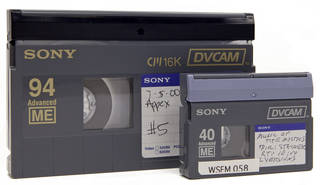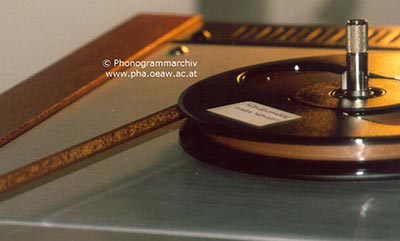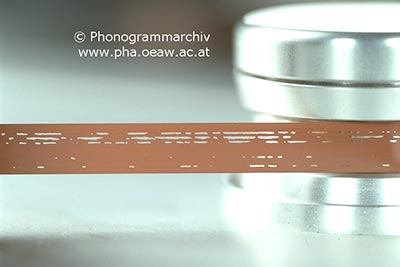| Table of Contents |
|---|
Introduction
...
DVCAM is a professional-quality variation of the DV video encoding that was introduced by Sony in 1996. DVCAM also refers to video tape recorders and DV and MiniDV videocassettes that are designed to support the DVCAM video recording specification. DVCAM uses the same tape width and compression scheme as DV but increases the track pitch from 10 microns to 15 microns. The recording speed of DVCAM is also significantly higher than DV cassettes. DVCAM recordings have improved colour rendition and robustness, employ “locked audio” tracks, and are well suited for linear editing environments. The DVCAM format was primarily used in professional markets for electronic news gathering, cable television, documentaries and other long form video production.
Identification
...
| Info | ||
|---|---|---|
| ||
Sony DVCAM PDVM-32N/3 32 Minutes. TapeOnline.com. Accessed February 22, 2021. |
| Info | ||
|---|---|---|
| ||
https://psap.library.illinois.edu/collection-id-guide/videotape#dvcamPreservation Self Assessment Program. "Videotape: DVCAM." University of Illinois at Urbana-Champaign. Accessed February 3, 2021. |
Physical Characteristics
...
| Tape width | ¼ inch (6.35mm) |
|---|---|
| Tape composition | Metal evaporate (ME) |
| Cassette dimensions | Large cassettes: 4 7/8" x 3" x 9/16" Small cassettes: 2 9/16" x 1 7/8" x 9/16" |
| Container dimensions | Large cassettes: 5 3/8" x 3 11/16" x 3/4" Small cassettes: 3 1/16" x 2 1/2" x 3/4" |
| Identifying features | Cassettes are usually bluish grey and are labeled as DVCAM in the upper righthand corner |
| Common manufacturers/brands | Sony |
| Playback | DVCAM tapes can be played using DVCAM, DV and DVCPRO VTRs DVCAM VTRs can playback DVCAM and DV tapes. |
...
| Storage environment: temperature | Ideal: 40–54°F (4.5–12°C) Acceptable: 55–60°F (13–15.5°C) |
|---|---|
| Storage environment: humidity | 30–50% RH |
| Container | DVCAM containers should pass the Photographic Activity Test (PAT) as specified ISO Standard 18916:2007
Containers are acceptable if they:
Unacceptable containers must be replaced with clean, inert containers. |
| Orientation of tape in storage | Vertical on its end (like books) |
Types of damage and deterioration
Binder deterioration
...
deterioration
...
Binder deterioration
| Info | ||
|---|---|---|
| ||
"1.1.3. Inspect for damage / Look for chemical deterioration / Binder degradation". In Audio Tape Digitisation Workflow. Accessed February 22, 2021. |
Description
Commonly known as "sticky shed syndrome." Affected records will have a visible gummy or powdery residue on the surface of the tape. This can damage both the recorded material and playback equipment. Back-coated tapes are most affected by this type of deterioration.
...
Baking: Holding the tape at an elevated temperature (45°C to 55°C) for a brief period of time (up to 36 hours) can temporarily remove moisture and allow normal playback for a period of one to two weeks. Tapes should not be rewound before baking.
Drop-out
https://www.musiikkiarkisto.fi/audio/audio113.html
| Info | ||
|---|---|---|
| ||
"1.1.3. Inspect for damage / Look for chemical deterioration / Binder degradation". In Audio Tape Digitisation Workflow. Accessed February 22, 2021. |
Description
A brief signal loss caused by a tape head clog, missing magnetic oxide particles, tape defect, or debris on the tape or machine. These factors can reduce head-to-tape spacing and result in the appearance of white spots or streaks on playback. Multiple drop-outs per frame will result in a snowy appearance.
...
Visit the /wiki/spaces/ALC/overview for further reading on /wiki/spaces/ALC/pages/1891631115.
References
...
AMIA. "Video Preservation Factsheets." Accessed December 10, 2020.
Bensinger, Charles. "Chapter 6: All about videotape." In The Video Guide, Second Edition, 71-75. Santa Barbara, California: Video-Info Publications, 1981.
Bogart, John Van. "What Can Go Wrong With Magnetic Media?" In Magnetic Tape Storage and Handling: A Guide for Libraries and Archives. Washington, DC: The Commission on Preservation and Access, 1995.
Casey, Mike. "FACET: Format characteristics and preservation problems." Bloomington, IN: Indiana University, 2007.
Gibson, Gerald. D. "Magnetic tape deterioration: recognition, recovery and prevention." Paper presented at the IASA Conference, Perugia, August 26, 1996.
Jimenez, Mona and Liss Platt. "Videotape Identification and Assessment Guide." Texas Commission on the Arts. 2004.
MediaCollege.com. "The DVCAM Format." Accessed February 3, 2021.
Museum of Obsolete Media. "DVCAM (1996 – )." Accessed February 3, 2021.
PCMag. "DVCAM." Accessed February 3, 2021.
Preservation Self Assessment Program. "Videotape: DVCAM." University of Illinois at Urbana-Champaign. Accessed February 3, 2021.
WDVA. "Do DV Formats Mystify You?" 2004.
Wheeler, Jim. "Videotape preservation handbook." 2002.
Wilt, Adam J. "The DV, DVCAM & DVCPRO Formats: The DV formats tabulated." August 28, 2005.
Wilt, Adam J. "The DV, DVCAM & DVCPRO Formats." July 16, 2006.
Version history
...
| Version | Date | Author(s) | Version Notes |
|---|---|---|---|
...



